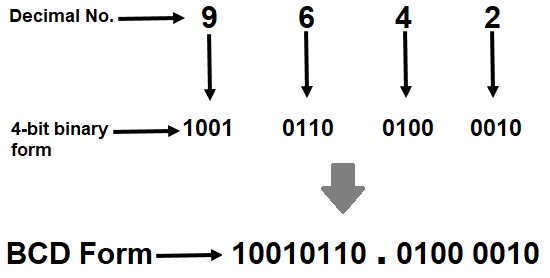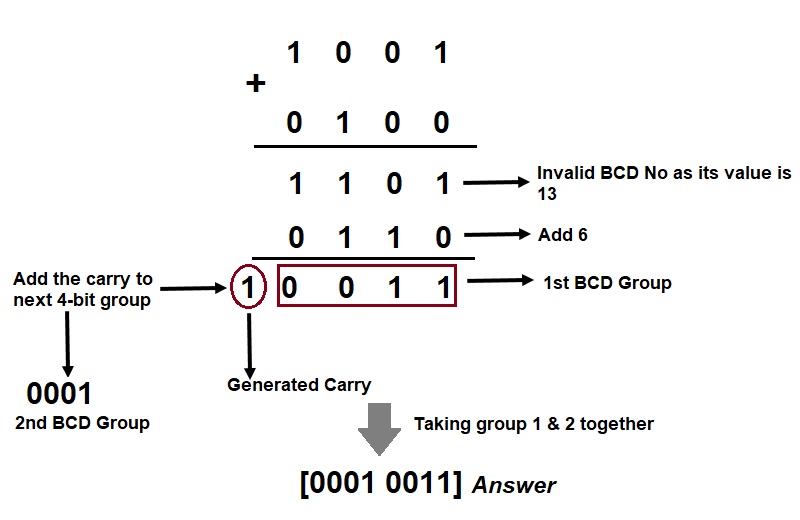What is Binary Coded Decimal Number?
Binary Coded Decimal number system is system in which decimal numbers from 0 to 9 are represented by four bit binary number. It is often called BCD number system.
Each bit of BCD number has a positional weight. The weights are assigned as per the position occupied by these digits. The weight of the first position (right most) is 20(1), the second 21(2), the third 22 (4) and the fourth 23(8). Reading from left to right, the weights are 8-4-2-1, and hence binary coded decimal number system is also called 8421 code.
The binary conversion of 7 is (111)2, but the same number is represented in Binary Coded Decimal system in four bit form as (0111). Also, the numbers from 0 to 9 are represented in the same way as in binary system but after 9 the representation in BCD are different. For example, the decimal number 12 in binary system is (1100)2 but the same number in BCD is represented as [0001 0010]. Note that each digit (1 & 2 separately) has been replaced by its equivalent 4-bit binary form.
The representation of decimal numbers from 0 to 15 in binary and equivalent binary coded decimal system is tabulated below:
| Decimal Number | Binary Number | Binary Coded Decimal (BCD) |
| 0 | 0000 | 0000 |
| 1 | 0001 | 0001 |
| 2 | 0010 | 0010 |
| 3 | 0011 | 0011 |
| 4 | 0100 | 0100 |
| 5 | 0101 | 0101 |
| 6 | 0110 | 0110 |
| 7 | 0111 | 0111 |
| 8 | 1000 | 1000 |
| 9 | 1001 | 1001 |
| 10 | 1010 | 0001 0000 |
| 11 | 1011 | 0001 0001 |
| 12 | 1100 | 0001 0010 |
| 13 | 1101 | 0001 0011 |
| 14 | 1110 | 0001 0100 |
| 15 | 1111 | 0001 0101 |
Method for Converting Decimal to Binary Coded Decimal (BCD):
To convert a decimal number into its equivalent binary coded decimal (BCD) form, each digit of the decimal number should be replaced by its equivalent four-bit binary form. The number so obtained is the BCD form. Let us make this clear using some examples.
Example-1: Give the BCD code for the decimal number 874.
Solution: Replace all digits i.e. 8, 7 and 4 by its equivalent 4-bit binary form. The 4-bit binary form of 8, 7 and 4 are (1000), (0111) and (0100) respectively. Refer table for getting the 4-bit binary form. Now, we will combine all these to get the BCD form.
So, the BCD equivalent of decimal number 874 is [1000 0111 0100]. (Answer)
Example-2: Give BCD code equivalent for the decimal number 96.42.
Solution: Replace all digits i.e. 9, 6, 4 & 2 by its equivalent 4-bit binary form. The conversion is shown below.

Rule for BCD Addition:
BCD is a numerical code. Many applications require arithmetic operations. Addition is the most important of theses because the other operation, namely subtraction, multiplication and division, can be done using addition.
The rule for addition of two binary coded decimal (BCD) numbers is given below.
- Add the two numbers using the rules for binary addition.
- If a four-bit sum is equal to or less than 9, it is a valid BCD number.
- If a four-bit sum is greater than 9, or if a carry-out of the group is generated, it is invalid result. Add 6 (0110)2 to the four-bit sum in order to skip he six invalid states and return the code to BCD. If a carry results when 6 is added, add the carry to the next four-bit group.
Example below illustrates the addition of two binary coded decimal (BCD) numbers. You can corelate the steps mentioned.
Example-3: Add the BCD numbers 1001 and 0100.
Solution:

If you have any doubt, kindly write in comment box. Your voice will never be lost here😊.
this website is too much informative and i took a loot of information